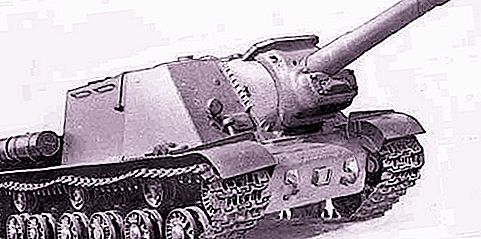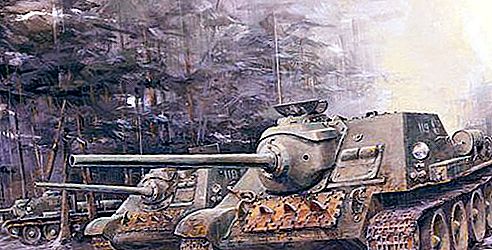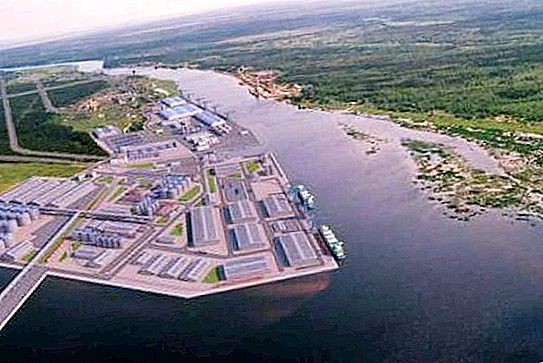Among the samples of Soviet military equipment from the time of the Great Patriotic War there is a place for the “St. John’s Wort” released in a relatively small number (670 copies), as the SU-152 self-propelled gun was called in the troops. There were two types of self-propelled guns that could be confused, especially since their names are very similar. The guns installed in the cabin of both cars are the same - this is a wonderful ML-20 cannon. But the chassis of the ISU-152 is much more powerful, it was inherited from the heavy tank IS-2.

The name of the self-propelled gun SU-152 stuck to both cars, but since there is still a difference between them, you should pay attention to the one that has a chassis from the KV, consider the history of its creation and the reasons for its appearance at the front.
Howitzer on a heavy tank chassis
This howitzer was already placed on the undercarriage of the KV tank, although it was done differently. During the war with Finland, siege weapons with the KV-2 rotating turret found combat use. These samples had a number of drawbacks, in particular, a very high profile, which unmasked the equipment and facilitated the entry of enemy weapons into it. In order to reduce the weight and height of self-propelled guns and simplify the technology of its production, in 1943 tank engineers from Chelyabinsk decided to install the gun in a fixed cabin. In December of that year, the development work was completed, and ChKZ began mass production.
There is nothing surprising in the name of the installation. SU-152 is deciphered: a self-propelled gun with a 152 mm gun.
Tank Destroyer
In fact, any oncoming battle of tank formations, according to classical tactical science, is a consequence of a command error. A competent officer or general must take care of the secretive concentration of his armored vehicles in that part of the enemy’s defense, where there will be no serious opposition. However, World War II broke established stereotypes, and tanks often fought with each other. By 1943, the Germans appeared “Tigers”, capable of inflicting tangible damage to Soviet armored vehicles from distant positions, so there was a need for its special class - a tank destroyer. The “St. John's wort, " as the SU-152 self-propelled gun was called almost immediately, was supposed to be just such a machine, although the ML-20 howitzer was created for another task - breaking through the fortified echelon positions of a well-entrenched enemy.
Advantages of SU-152
It is not known how the German tank crew called the SU-152 self-propelled gun, but it caused them a lot of trouble. Soviet self-propelled guns could fire from hidden positions along a hinged path, however, for this they needed landmarks or adjustments.
The main advantage of the new technology was the heavy-duty caliber and the long range of aimed fire. The mass of the shell ranged from 40 to 49 kilograms, and when hit guaranteed to destroy any armored target. The real range, which allows one to reasonably hope for such a result, was a distance of 1800 meters. The chassis and mechanics had design flaws, but there were no more of them than the main enemy - the Tiger T-VI.
At first glance, these are very impressive characteristics, but there were problems that made it possible to doubt that the nickname of the SU-152 self-propelled gun was well founded.
The main "beast"
In order to objectively assess the chances of our self-propelled guns during an artillery duel with the Tiger, it is necessary to compare the capabilities of these machines in such a situation.
So, the first thing you should pay attention to is the range of aimed fire. It is approximately the same for these two samples, but it should be noted that the quality of the German Carl Zeiss optics is higher than ours, although Soviet sights can not be called bad.
The second important factor is rate of fire. Our self-propelled gunners could fire just two shots in a minute, the heavy weight of the projectile (up to 60 kg) and the tightness in the wheelhouse interfered. The Germans during the same time could shoot six times.
The subject of the third comparison is the caliber. This is exactly what caused the unofficial name of the self-propelled gun SU-152. Here, the superiority of our SPG over the enemy "beast" is indisputable. Where are 88 millimeters against our 152's! The trouble was that the German caliber was enough to penetrate the six-centimeter armor of the Soviet self-propelled guns. And the Germans had much more shells in the ammunition - 90 against our twenty. And yet, at the Tiger, the tower rotated with an electric motor, and the ML-20 had a twist angle of only 12 degrees in each direction.







